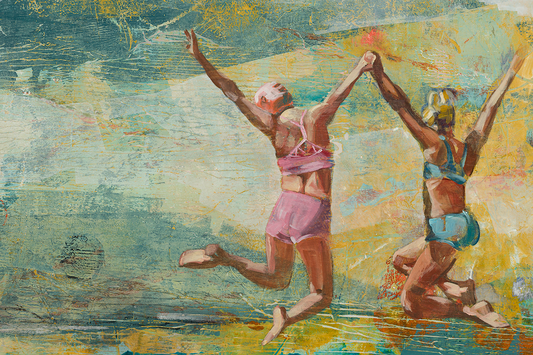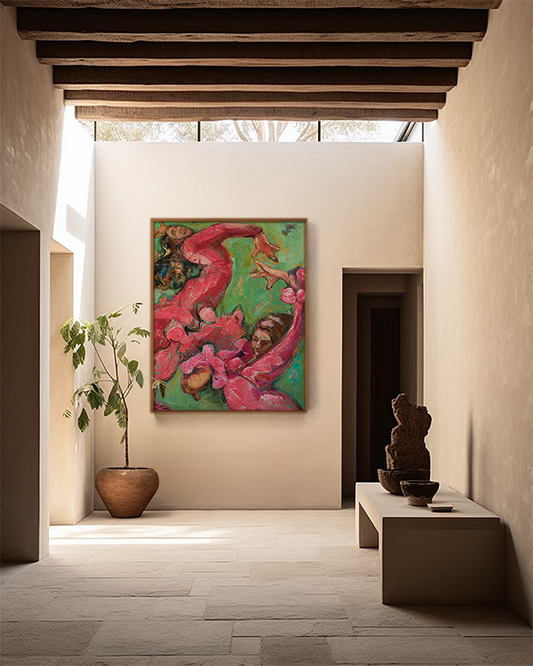Understanding Opposites: Lessons From an 8-Year-Old and the Painting Disappearing Waters
Share

When Fear and Love Exist in the Same Moment
When my daughter was 8 years old, we took our first family trip to Hawaii and the island of Maui. She fell in love.
But all was not well. My keenly sensitive and aware young child started making comments about some of her concerns with our environment. She told me how much she loved Hawaii—so much so that when she grows up, she wants to live there. But then came the fear: What if Hawaii gets destroyed before she has the chance to do that?
Her biggest fear was that by the time she had the freedom to move, Hawaii might not be the beautiful place she had experienced.
It was worrying to me that she was thinking ahead so much in such a catastrophic way instead of just enjoying where she was in the moment. She is a planner, and as such, she was planning for the worst in her future.
The Fragile Truth About Children's Perceptions
There is a hard truth as a parent that you start to recognize within your children: their perceptions can be fragile.
My instinct is to immediately soothe over her fears and reassure her of only positive outcomes. But I have learned that it is better to accept their fears as valid emotions and not try to manipulate them. It was okay that she had that worry—it was a reasonable place to be.
Throughout elementary school, there is a lot of focus on learning about the environment and how to take care of it. But there is a subtle underlying text that my child was either picking up or reading into: the adults have made a mistake and have not done a good job of taking care of their environment, and it is up to you to take good care of it and correct our mistakes.
This was not necessarily the lesson given, but when you have the tendency to take on the world, this may be the message you hear.
When Two Truths Can Exist at Once
The reality: Hawaii may not stay the same. It may not be the way she remembered it as an 8-year-old child.
Something you love may not stay the way you remembered it, AND you can still love it. AND you can still be you.
We can ALL learn better ways to treat the environment. It is not an appropriate heavy cross for such small shoulders to bear.
What I Didn't Know I Was Painting
As all of this was transpiring, I was painting, like always. And all of these life experiences filter into whatever I am painting in the moment. At the time, I was working on this painting, Disappearing Waters—although I did not know it was titled that until after I had finished the piece and was wondering what to name it.

It started like many of my other works: a 24 x 24 inch cradled panel, and playing with paint. I started with choosing some colors to work with and laying down passages of those colors in various ways. Orange, blue, white—some layers were thick, some were thin, almost watery in places. They blended together here and there, thicker areas emerging through thin passages. With light sanding, more color popped through here and there in unexpected ways.

I always like to introduce some line into a painted surface, so I played around with some orange crayon looping marks—some which stayed visible in the final piece and some are buried under more paint.
The figures were found as an image saved in my stockpile of photos that I save for reference. For whatever reason, the imagery piqued my interest, and when I projected the image onto the canvas, it was compelling enough to keep it. Once they were initially painted in, I added more layers of paint, sanding between each to integrate the foreground and the background.
At this point, I was still making visual decisions. I really did not recognize the story of what I was painting.
The Discovery After It Was Done
When it was complete, I had to give this painting a title. That is when I reflected on what the imagery meant to me.
With the title came the story. It is like a book with no words where the letters start to magically appear on the page so you can read the story. It all made sense to me then, but the painting seemed to know before I did.
This piece was my insight into understanding that two seemingly opposing thoughts can be true at the same time:
- Nature is powerful and nature is fragile
- We can love something and fear losing it and still keep loving it
- Joy and uncertainty can exist in the same moment
What Viewers See vs. What I See
I have had several people comment on the joyfulness of the imagery—that the imagery reminds them somehow of their childhood, of innocence and play.
Where a viewer may see joy, nostalgia, and lightness, I see a more complete picture: hope and uncertainty finding a semblance of peace together.
The landscape is fading, uncertain, and fragile, and the orange crayon loops show some playful marks still visible through it all. The children are in their element of happiness and play, leaping into a body of water that may or may not be there.
Are they in their happy place, or are they seeing doubts of the future?
The painting depicts a space where both truths can exist.
The Beginning of a Series
Disappearing Waters is the first piece in a series called Educated Hoops & Disappearing Landscapes, which I continue to work on today.
The series explores our environment and our children's relationship to it. It depicts how adult concerns about the future filter into our children's fears. And it also reflects the impossible weight of learning from our adults' mistakes AND the expectation of growing up to be better adults.
Where It Lives Now
Magically, today this painting now lives on one of the islands of Hawaii, in a custom-built home, very likely overlooking the ocean. The painting found its way to my daughter's hope for the future.
The original is sold, but prints are available in three different sizes with framing options. [Link to prints]
You can read more stories about my work by signing up for my newsletter, The Artful Journey, and follow along on the creative journey. [Newsletter signup link]



